Hankun Wang
Towards General Discrete Speech Codec for Complex Acoustic Environments: A Study of Reconstruction and Downstream Task Consistency
May 28, 2025Abstract:Neural speech codecs excel in reconstructing clean speech signals; however, their efficacy in complex acoustic environments and downstream signal processing tasks remains underexplored. In this study, we introduce a novel benchmark named Environment-Resilient Speech Codec Benchmark (ERSB) to systematically evaluate whether neural speech codecs are environment-resilient. Specifically, we assess two key capabilities: (1) robust reconstruction, which measures the preservation of both speech and non-speech acoustic details, and (2) downstream task consistency, which ensures minimal deviation in downstream signal processing tasks when using reconstructed speech instead of the original. Our comprehensive experiments reveal that complex acoustic environments significantly degrade signal reconstruction and downstream task consistency. This work highlights the limitations of current speech codecs and raises a future direction that improves them for greater environmental resilience.
Recent Advances in Discrete Speech Tokens: A Review
Feb 10, 2025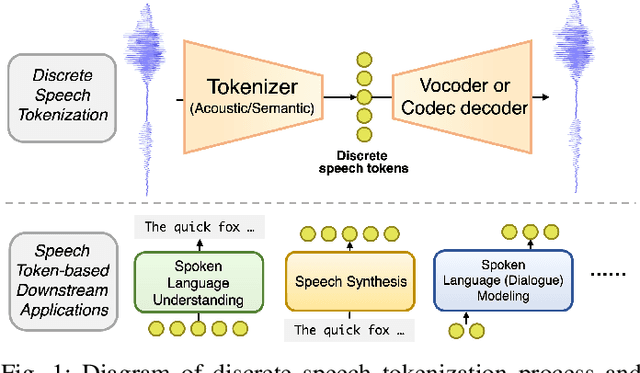
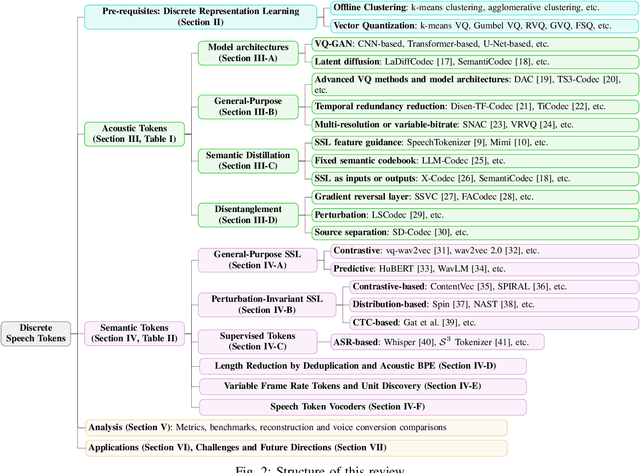

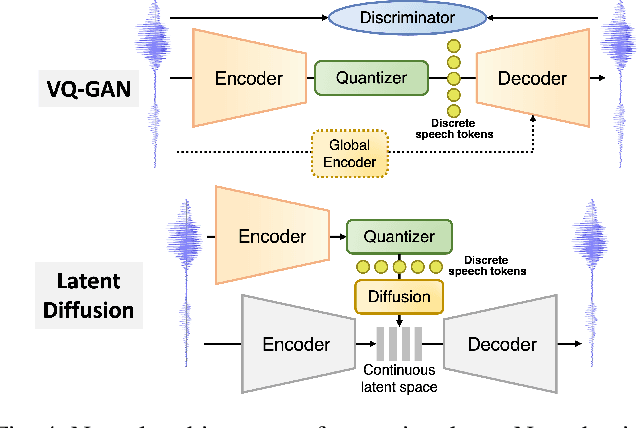
Abstract:The rapid advancement of speech generation technologies in the era of large language models (LLMs) has established discrete speech tokens as a foundational paradigm for speech representation. These tokens, characterized by their discrete, compact, and concise nature, are not only advantageous for efficient transmission and storage, but also inherently compatible with the language modeling framework, enabling seamless integration of speech into text-dominated LLM architectures. Current research categorizes discrete speech tokens into two principal classes: acoustic tokens and semantic tokens, each of which has evolved into a rich research domain characterized by unique design philosophies and methodological approaches. This survey systematically synthesizes the existing taxonomy and recent innovations in discrete speech tokenization, conducts a critical examination of the strengths and limitations of each paradigm, and presents systematic experimental comparisons across token types. Furthermore, we identify persistent challenges in the field and propose potential research directions, aiming to offer actionable insights to inspire future advancements in the development and application of discrete speech tokens.
AdaEAGLE: Optimizing Speculative Decoding via Explicit Modeling of Adaptive Draft Structures
Dec 25, 2024



Abstract:Speculative Decoding (SD) is a popular lossless technique for accelerating the inference of Large Language Models (LLMs). We show that the decoding speed of SD frameworks with static draft structures can be significantly improved by incorporating context-aware adaptive draft structures. However, current studies on adaptive draft structures are limited by their performance, modeling approaches, and applicability. In this paper, we introduce AdaEAGLE, the first SD framework that explicitly models adaptive draft structures. AdaEAGLE leverages the Lightweight Draft Length Predictor (LDLP) module to explicitly predict the optimal number of draft tokens during inference to guide the draft model. It achieves comparable speedup results without manual thresholds and allows for deeper, more specialized optimizations. Moreover, together with threshold-based strategies, AdaEAGLE achieves a $1.62\times$ speedup over the vanilla AR decoding and outperforms fixed-length SotA baseline while maintaining output quality.
Why Do Speech Language Models Fail to Generate Semantically Coherent Outputs? A Modality Evolving Perspective
Dec 22, 2024



Abstract:Although text-based large language models exhibit human-level writing ability and remarkable intelligence, speech language models (SLMs) still struggle to generate semantically coherent outputs. There are several potential reasons for this performance degradation: (A) speech tokens mainly provide phonetic information rather than semantic information, (B) the length of speech sequences is much longer than that of text sequences, and (C) paralinguistic information, such as prosody, introduces additional complexity and variability. In this paper, we explore the influence of three key factors separately by transiting the modality from text to speech in an evolving manner. Our findings reveal that the impact of the three factors varies. Factor A has a relatively minor impact, factor B influences syntactical and semantic modeling more obviously, and factor C exerts the most significant impact, particularly in the basic lexical modeling. Based on these findings, we provide insights into the unique challenges of training SLMs and highlight pathways to develop more effective end-to-end SLMs.
Fast and High-Quality Auto-Regressive Speech Synthesis via Speculative Decoding
Oct 29, 2024



Abstract:The auto-regressive architecture, like GPTs, is widely used in modern Text-to-Speech (TTS) systems. However, it incurs substantial inference time, particularly due to the challenges in the next-token prediction posed by lengthy sequences of speech tokens. In this work, we introduce VADUSA, one of the first approaches to accelerate auto-regressive TTS through speculative decoding. Our results show that VADUSA not only significantly improves inference speed but also enhances performance by incorporating draft heads to predict future speech content auto-regressively. Furthermore, the inclusion of a tolerance mechanism during sampling accelerates inference without compromising quality. Our approach demonstrates strong generalization across large datasets and various types of speech tokens.
LSCodec: Low-Bitrate and Speaker-Decoupled Discrete Speech Codec
Oct 21, 2024Abstract:Although discrete speech tokens have exhibited strong potential for language model-based speech generation, their high bitrates and redundant timbre information restrict the development of such models. In this work, we propose LSCodec, a discrete speech codec that has both low bitrate and speaker decoupling ability. LSCodec adopts a three-stage unsupervised training framework with a speaker perturbation technique. A continuous information bottleneck is first established, followed by vector quantization that produces a discrete speaker-decoupled space. A discrete token vocoder finally refines acoustic details from LSCodec. By reconstruction experiments, LSCodec demonstrates superior intelligibility and audio quality with only a single codebook and smaller vocabulary size than baselines. The 25Hz version of LSCodec also achieves the lowest bitrate (0.25kbps) of codecs so far with decent quality. Voice conversion evaluations prove the satisfactory speaker disentanglement of LSCodec, and ablation study further verifies the effectiveness of the proposed training framework.
vec2wav 2.0: Advancing Voice Conversion via Discrete Token Vocoders
Sep 03, 2024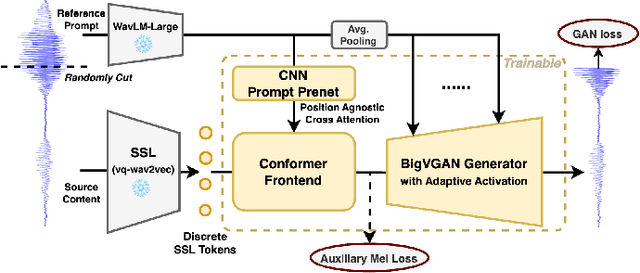
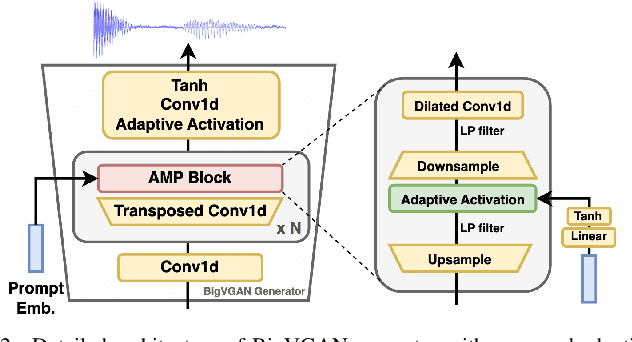
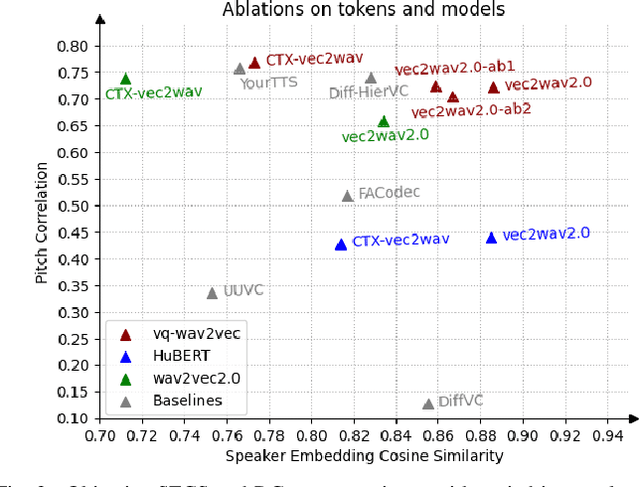

Abstract:We propose a new speech discrete token vocoder, vec2wav 2.0, which advances voice conversion (VC). We use discrete tokens from speech self-supervised models as the content features of source speech, and treat VC as a prompted vocoding task. To amend the loss of speaker timbre in the content tokens, vec2wav 2.0 utilizes the WavLM features to provide strong timbre-dependent information. A novel adaptive Snake activation function is proposed to better incorporate timbre into the waveform reconstruction process. In this way, vec2wav 2.0 learns to alter the speaker timbre appropriately given different reference prompts. Also, no supervised data is required for vec2wav 2.0 to be effectively trained. Experimental results demonstrate that vec2wav 2.0 outperforms all other baselines to a considerable margin in terms of audio quality and speaker similarity in any-to-any VC. Ablation studies verify the effects made by the proposed techniques. Moreover, vec2wav 2.0 achieves competitive cross-lingual VC even only trained on monolingual corpus. Thus, vec2wav 2.0 shows timbre can potentially be manipulated only by speech token vocoders, pushing the frontiers of VC and speech synthesis.
Attention-Constrained Inference for Robust Decoder-Only Text-to-Speech
Apr 30, 2024Abstract:Recent popular decoder-only text-to-speech models are known for their ability of generating natural-sounding speech. However, such models sometimes suffer from word skipping and repeating due to the lack of explicit monotonic alignment constraints. In this paper, we notice from the attention maps that some particular attention heads of the decoder-only model indicate the alignments between speech and text. We call the attention maps of those heads Alignment-Emerged Attention Maps (AEAMs). Based on this discovery, we propose a novel inference method without altering the training process, named Attention-Constrained Inference (ACI), to facilitate monotonic synthesis. It first identifies AEAMs using the Attention Sweeping algorithm and then applies constraining masks on AEAMs. Our experimental results on decoder-only TTS model VALL-E show that the WER of synthesized speech is reduced by up to 20.5% relatively with ACI while the naturalness and speaker similarity are comparable.
The X-LANCE Technical Report for Interspeech 2024 Speech Processing Using Discrete Speech Unit Challenge
Apr 10, 2024Abstract:Discrete speech tokens have been more and more popular in multiple speech processing fields, including automatic speech recognition (ASR), text-to-speech (TTS) and singing voice synthesis (SVS). In this paper, we describe the systems developed by the SJTU X-LANCE group for the TTS (acoustic + vocoder), SVS, and ASR tracks in the Interspeech 2024 Speech Processing Using Discrete Speech Unit Challenge. Notably, we achieved 1st rank on the leaderboard in the TTS track both with the whole training set and only 1h training data, with the highest UTMOS score and lowest bitrate among all submissions.
VALL-T: Decoder-Only Generative Transducer for Robust and Decoding-Controllable Text-to-Speech
Jan 30, 2024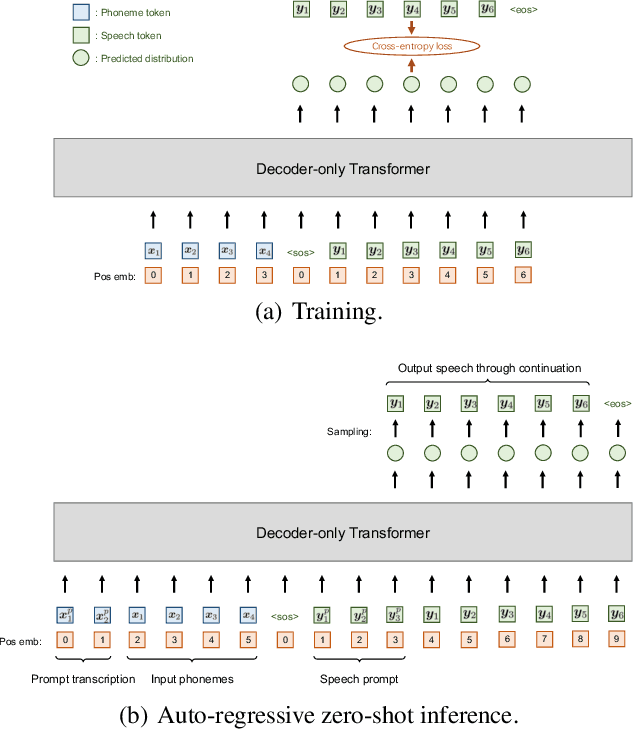
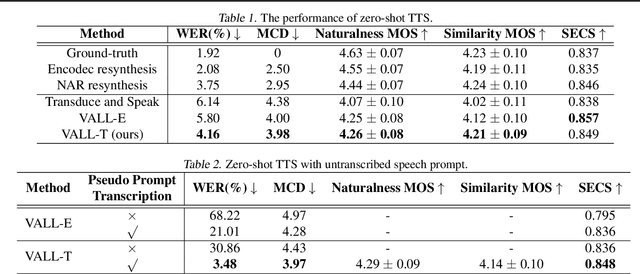
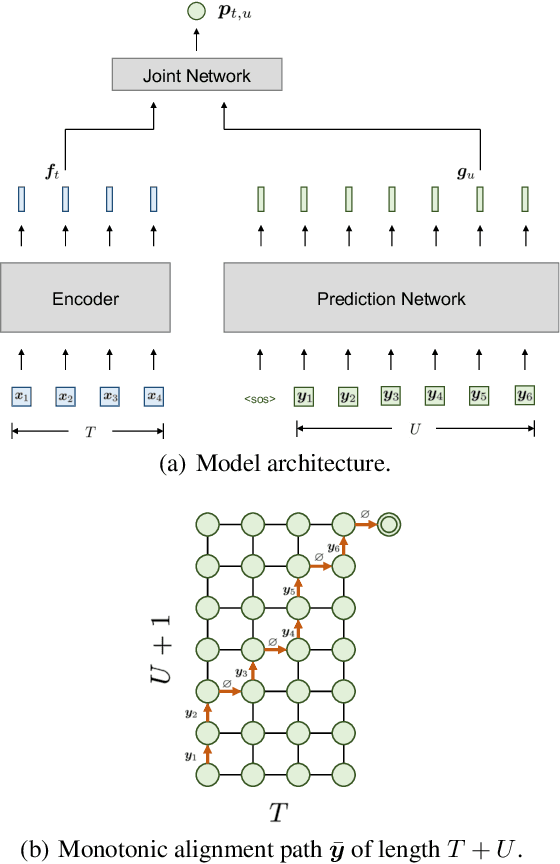
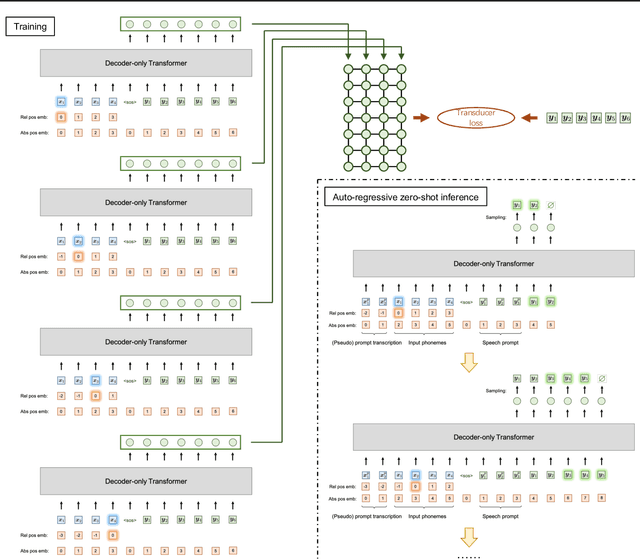
Abstract:Recent TTS models with decoder-only Transformer architecture, such as SPEAR-TTS and VALL-E, achieve impressive naturalness and demonstrate the ability for zero-shot adaptation given a speech prompt. However, such decoder-only TTS models lack monotonic alignment constraints, sometimes leading to hallucination issues such as mispronunciation, word skipping and repeating. To address this limitation, we propose VALL-T, a generative Transducer model that introduces shifting relative position embeddings for input phoneme sequence, explicitly indicating the monotonic generation process while maintaining the architecture of decoder-only Transformer. Consequently, VALL-T retains the capability of prompt-based zero-shot adaptation and demonstrates better robustness against hallucinations with a relative reduction of 28.3% in the word error rate. Furthermore, the controllability of alignment in VALL-T during decoding facilitates the use of untranscribed speech prompts, even in unknown languages. It also enables the synthesis of lengthy speech by utilizing an aligned context window.
 Add to Chrome
Add to Chrome Add to Firefox
Add to Firefox Add to Edge
Add to Edge